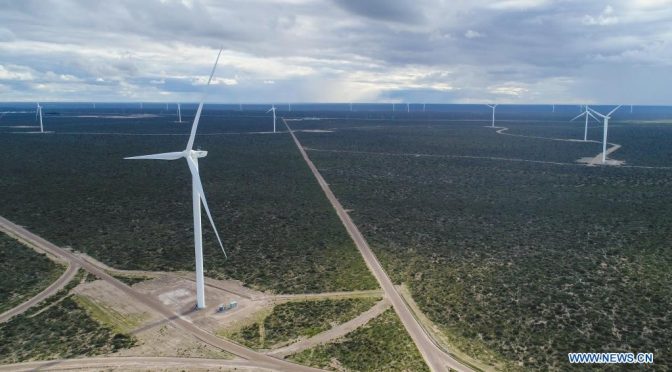Four wind power parks with Chinese technology began operating in Argentina since last April, managing to join the Argentine Interconnection System (SADI), contributing to the transformation of the energy matrix of the South American country.
It is the “Loma Blanca” wind complex located in the province of Chubut (south) with three of its four parks connected to the national electricity service, as well as the “Miramar” park in the southeast of the province of Buenos Aires, all built by Goldwind and PowerChina Ltd.
After successfully completing the installation of 109 wind turbines, distributed between Chubut and the coastal city of Miramar, both complexes now have a total power of 354.6 megawatts (MW) and a useful life of approximately 20 years, explained the directors of the project after a tour carried out by Xinhua through the parks of “Loma Blanca”.
The last phase of construction of the work and its subsequent connection to the electrical system could materialize despite the difficulties brought by the new coronavirus disease (COVID-19) throughout 2020, one of them being the increase in costs in the supply chains, explained Xin Liu, a member of the General Management of the wind project.
Germán Gigena, electricity and electronics technician in the “Loma Blanca” project, indicated that with the pandemic they had to develop “security protocols in the company, the working group was also divided, we had two guards so that if a (member of a group) was contagious, that group was isolated, but there was always a group that remained in maintenance, we never lost the maintenance of the machines “.
The five parks constitute the largest wind energy project developed by a Chinese company in Argentina in recent years and throughout its construction, at least 1,500 sources of employment were generated locally.
“These projects have promoted the training of local wind power operation and maintenance personnel, and have continued to inject green energy into Argentina’s development,” Xin Liu said.
The largest of the complexes, that of Loma Blanca I, II, III and VI, is located between the towns of Trelew and Puerto Madryn, and has 80 wind turbines that in total add up to a capacity of 256 MW.
One of the plants is in the final testing phase waiting to be authorized for incorporation into SADI.
The Chubut and Miramar towers have important technological advantages compared to other wind projects installed in the country, one of these being direct transmission technology that allows “to reduce transmission loss, improve the efficiency of power generation and achieve a more stable operation, “explained the member of the management team.
“Direct drive technology reduces the number of parts and components in the wind turbine, so there is no need to replace the gearbox oil, it has low operating and maintenance costs and has cleaner working conditions,” he added .
The parks constitute one of the many cooperation and energy transformation projects between the governments of China and Argentina, and are part of the Belt and Road Initiative of the Asian country.
For Xin Liu, this initiative represents “a peaceful model of economic development” that can bring industrial complementarity between the two countries.
“Argentina has abundant natural resources and agricultural products can complement China’s rapidly growing demand, while China’s relatively complete manufacturing chain can also compensate for the lack of industrial development in Argentina,” he said.
“The two countries are naturally complementary. Goldwind can invest in Argentina’s new energy sector and has also built a new bridge for China-Argentina cooperation, hoping to provide solutions from China for the Argentine wind industry,” he added.
Along the same lines, Argentine technicians and workers highlighted the multiple benefits of bilateral cooperation, as well as the generation of alternative energy sources.
“This investment in Argentina was very good, if one day we want to have a country with an industry we need energy and the best we can have is clean energy, wind energy,” said Gigena.
For his part, Juan Mendoza, technician in the Operations and Maintenance area of ??the “Loma Blanca” project, assured that the South American country will benefit “despite the cultural clash between China and Argentina, where we do not know much about the other.”
“It is good that we are learning precisely from each other, and that they can contribute to us in the field of wind energy, since Argentina is still in the pre-construction phase of some parks,” he added.


